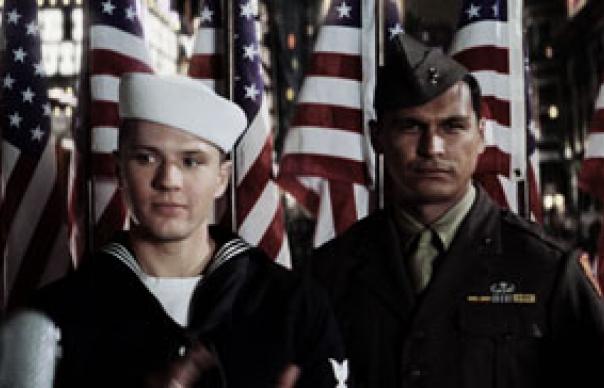Clint Eastwood in the twilight of his career continues to amaze. In the decade following the Oscar-winning Unforgiven, he seemed wholly to have surrendered to humdrum mediocrity. But in a career renaissance comparable to Bob Dylan’s cussed reluctance to leave the building quietly, Eastwood has rallied spectacularly, as if being remembered latterly for not much more than a comely spoof like Space Cowboys was simply an unbearable notion.
Mystic River (2003) was an unexpected revival and won Oscars for two of its stars, Sean Penn and Tim Robbins. What followed, extraordinarily, was Clint’s masterpiece to date – 2005’s Million Dollar Baby, a film about life, love, death and boxing that Hollywood first refused to bankroll and then honoured with multiple Academy Awards, including Best Film and Best Director. Two years on, here’s Clint at 76 with Flags Of Our Fathers, an epic project that would have been daunting for a director half his age, and his second classic on the trot.
A film of awesome emotional power and angry intent, Flags Of Our Fathers is based on the best-selling book by James Bradley, whose father, John “Doc” Bradley, was one of the six US servicemen in the iconic photo by Joe Rosenthal of the American flag being raised over the Japanese island of Iwo Jima, site of one of the bloodiest battles of WW2.
Rosenthal’s picture was emblematic of uncommon valour, heroism on a grand scale, noble sacrifice, the triumph of the incontestably good over the demonstrably evil. I’d always imagined it had been taken in so-called heat of battle, bullets flying everywhere, the Americans on their way to victory after days of fixed-bayonet carnage. Which is certainly the impression you get from Allan Dwan’s 1949 John Wayne vehicle, Sands Of Iwo Jima, which has the Duke dying – shot in the back! – as the Stars And Stripes goes up on Mt Suribachi.
As Eastwood now provocatively reminds us, however, an American flag was indeed hoisted above Iwo Jima in the maw of battle – but it wasn’t the flag in Rosenthal’s photograph, which went up during a lull in the fighting as a replacement for the original banner, and was erected by five marines and a Navy medic who had been bloodily engaged elsewhere when the first flag was put up. The six men in Rosenthal’s picture – by now inspiring war-weary America – were nevertheless treated as heroes of the battle, and Washington enlisted them as part of a huge propaganda campaign to raise war bonds to pay for one last push against the Japanese.
Three of them were by now dead, but “Doc” Bradley (Ryan Phillipe), the opportunistic 19 year old Rene Gagnon (Jesse Bradford) and Ira Hayes (Adam Beach) were flown back to the States where they reluctantly starred in a touring pageant celebrating their illustrious exploits on Iwo Jima, even as their buddies were still dying in the Pacific.
The trio quickly realise they are now a showbiz turn, no one much interested in the truth of what happened on Iwo, everyone eager to buy into the myth, the legend created by Rosenthal’s powerfully evocative image of courage under apparent fire. The deeply-troubled Hayes, a Pima Indian, is especially vulnerable to the bitter contradictions of his new circumstances. Lauded on the one hand as a hero he doesn’t think he is, on the other treated with patronising racism, he is destroyed by alcoholism. Beach tears up the screen as Hayes.
Eastwoood handles the film’s parallel storylines with astonishing confidence and technical dexterity, working from a superb script by Paul Haggis (who wrote Million Dollar Baby) and William Broyles Jr (Jarhead). The home front propaganda machine and its affect on the men it’s exploiting is mercilessly ridiculed, as are notions of unthinking patriotism and the re-writing of history for political advantage, which gives the film a resonant timeliness.
The battle scenes, meanwhile, are staggering. The vast invasion fleet and initial landings are rendered epically, and will no doubt put people in mind of Saving Private Ryan. But it’s the point-blank ferocity of a war fought at fearsomely close quarters that sets you reeling, makes you think of the hand-to-hand combat scenes of Sam Fuller’s Merrill’s Marauders, Peckinpah’s Cross Of Iron and Don Siegel’s Hell Is For Heroes.
Fascinatingly, Eastwood’s simultaneously filmed the same story from a Japanese perspective in Letters From Iwo Jima, which will be released next February. It promises to complete an extraordinary double from a film maker whose second wind is turning into a full force creative gale.
ALLAN JONES


